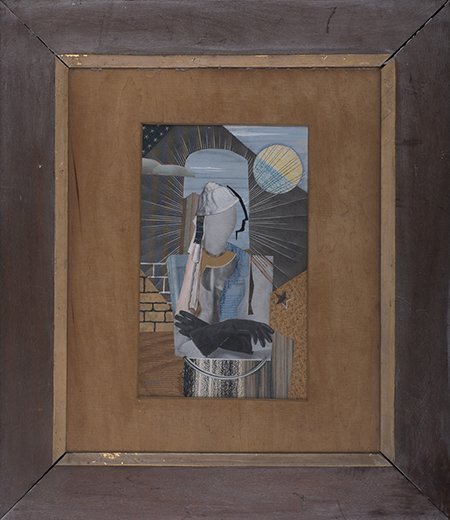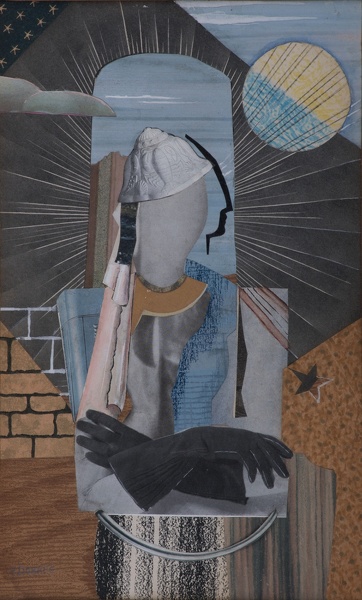Provenance: Private Collection
Literature: Llewellyn, Sacha, and Paul Liss. Portrait of an Artist. Liss Llewellyn, 2021, p.320.

“She has given so much of herself to the world, lived so fiercely it
is splendid...” So wrote fellow artist Dora Carrington of her friend
Valentine Dobrée, the beautiful, aristocratic yet volatile daughter of an
English diplomat who lived her life variously as novelist, poet and artist.
She was perhaps best known for her book Your Cuckoo Sings by Kind,
published in 1927 and celebrated at the time for its bold treatment of
sexuality, yet since the early 1920s had been producing (and exhibiting)
artworks in differing styles created with a self-conscious knowledge
of recent avant-garde movements and ideas. One such example is this
work Black Gloves, a curious collage that hovers between figuration and
abstraction and which both reveals and conceals.
Blocks of pattern form the background to the central section which
resembles a fragmented figure out of which radiate numerous thin white
lines. There is an energy to this figure. The folded arms of the gloves,
the profile of the head outlined in black seem to tell us more than the
decorative. Was this intended to be Dobrée’s veiled self-portrait – an
image with which she wished to declare: “Here I am, liberated, sexualised
and in control”? – one might wonder, as Dobrée enjoyed a lively love
life at a time when relationships among the bohemia were fluid. Married
in 1913 to the well-connected Bonamy Dobrée, she also had affairs
with painter Mark Gertler, the Bloomsburyite Ralph Partridge and with
the solider poet Richard Adlington. Lytton Strachey noticed that she
was “perhaps a Saph...much attracted to [Dora Carrington]”. Dora,
for her part, was deeply fond of Dobrée, “I admire the ways she has no
preconceived conception of how a woman and an artist should live...”
Commentary by Simon Grant, Editor of Tate Etc magazine, Co-Editor of Picpus magazine and also curates exhibitions, most recently Paul Nash at the Fondation Vincent van Gogh, Arles.
















